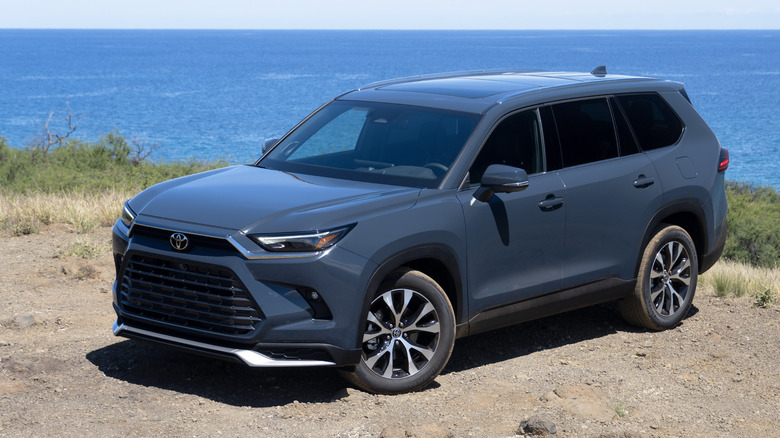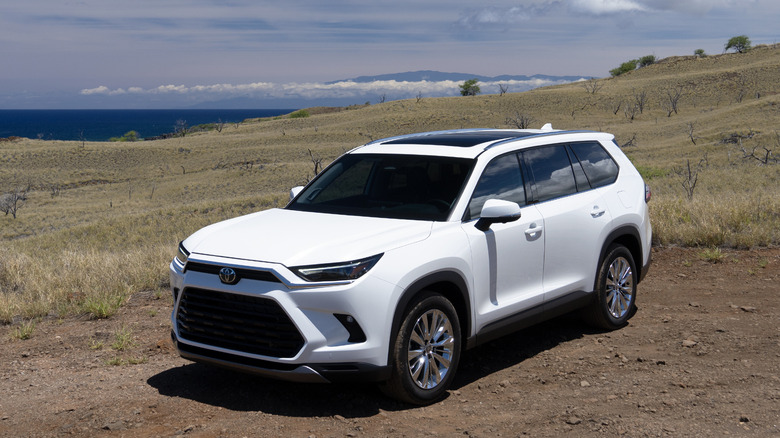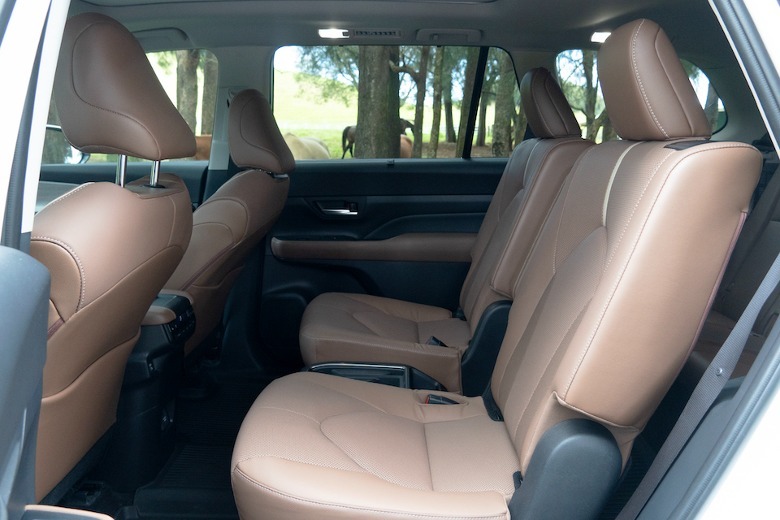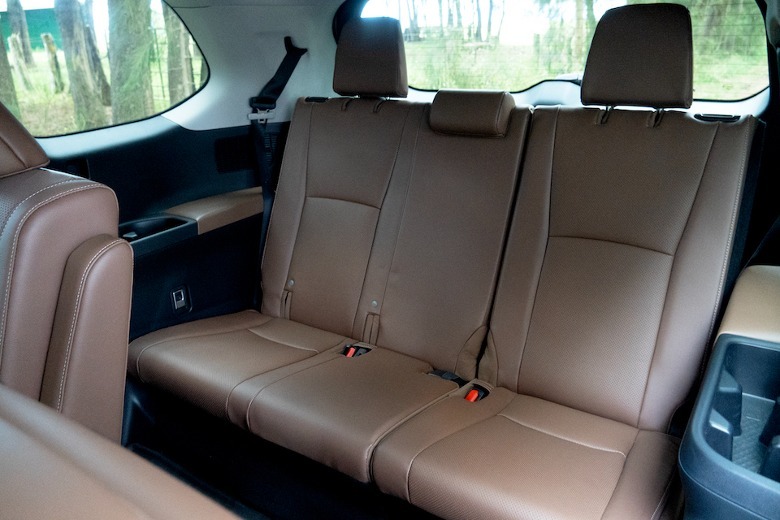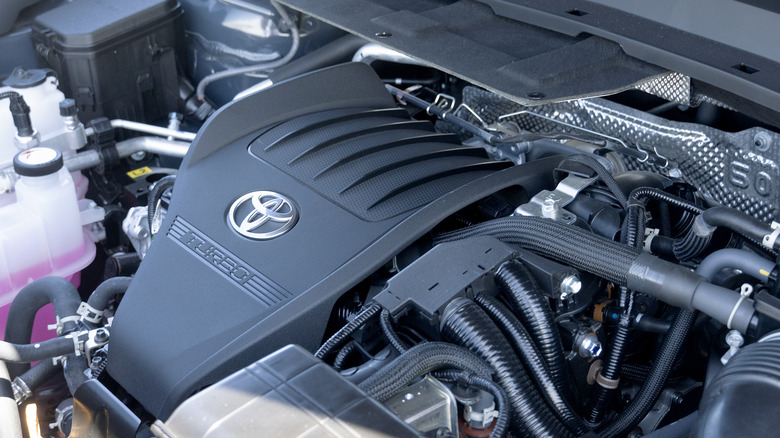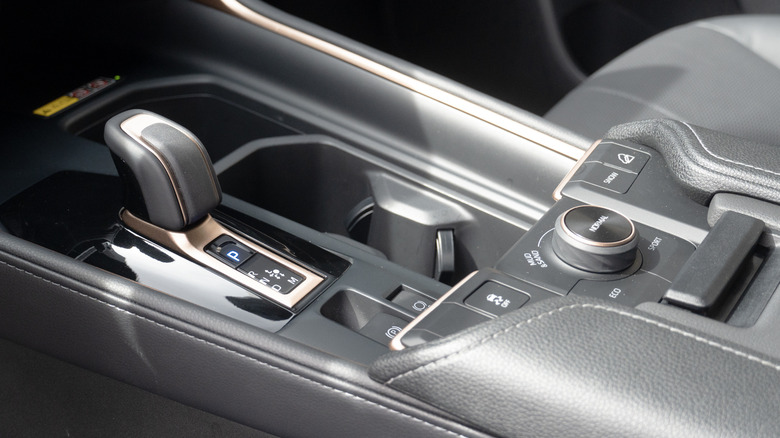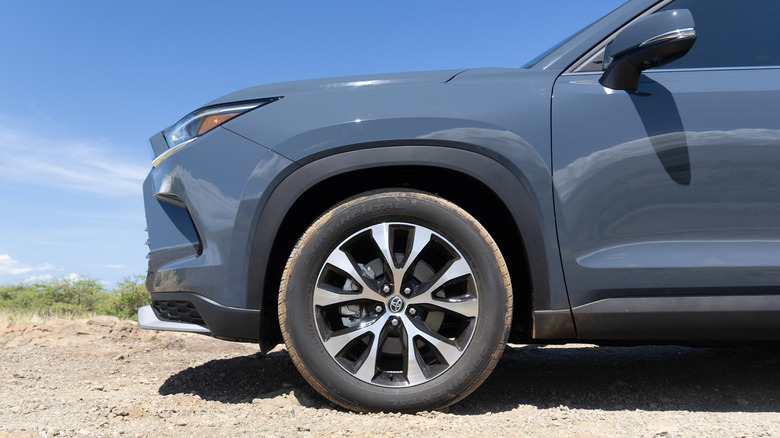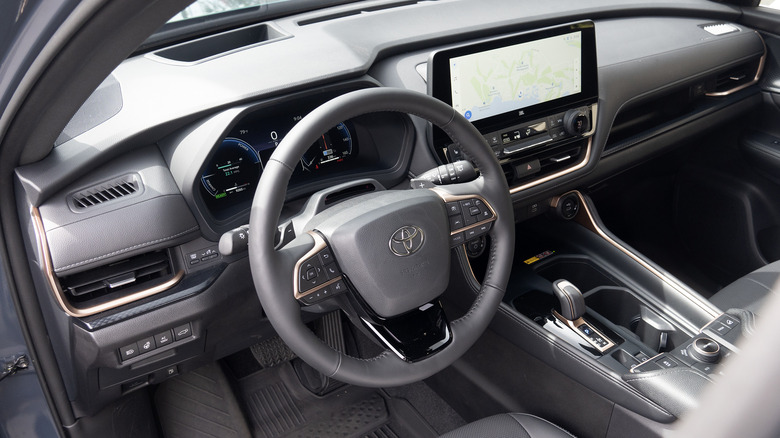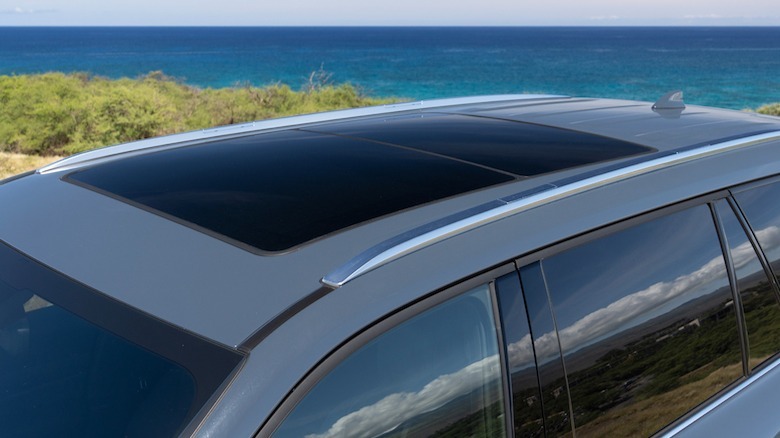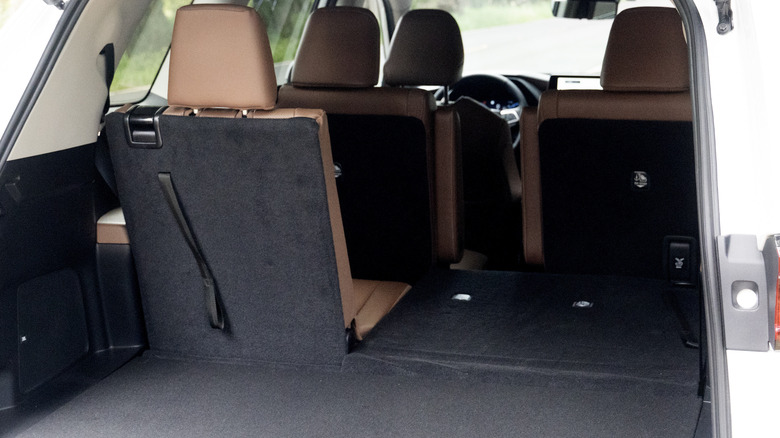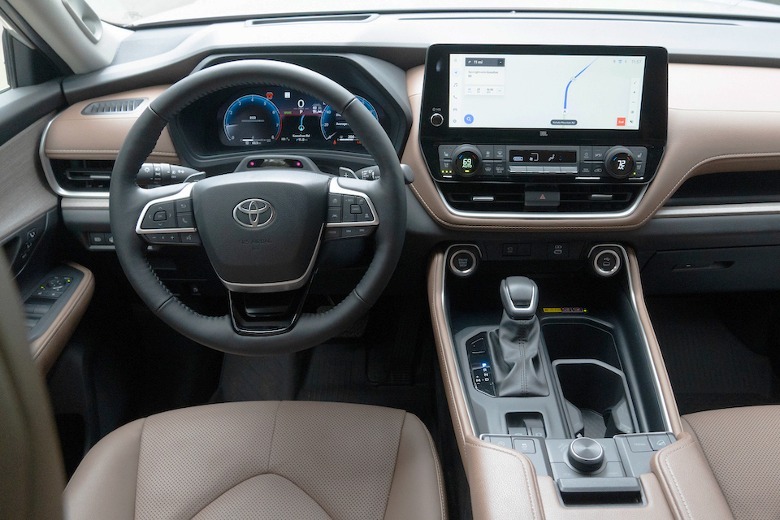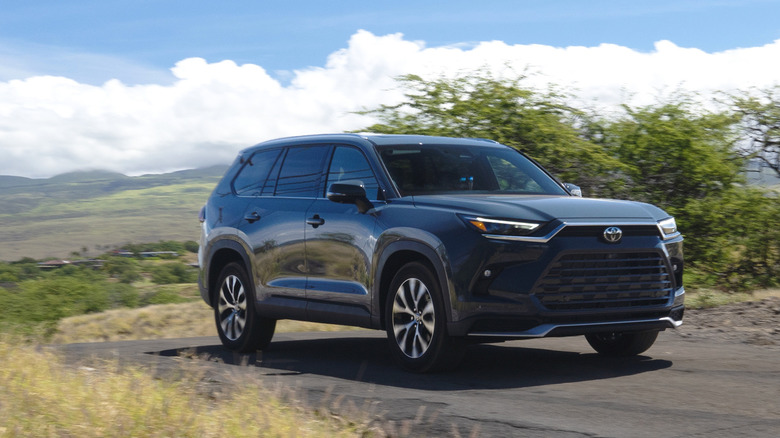2024 Toyota Grand Highlander First Drive: Hybrid Power Paired With 3-Row Space
Crossovers might dominate the American market for new vehicles, and especially EVs, but Toyota clearly sees untapped potential in the three-row SUV segment. In many ways, the all-new 2024 Grand Highlander blurs the lines between crossovers and SUVs, with the size and versatility of a family hauler but the unibody construction and driving dynamics of a more conventional car.
Grand Highlander slots in between the mid-sized (also three-row, but slightly more cramped) Highlander from which it borrows nomenclature, and the larger body-on-frame (also three-row, but more spacious) Sequoia that borrows a chassis from the Tundra. But of course, in the modern era, Toyota couldn't deliver a strictly gas-powered SUV—looking at you, Infiniti QX60—so powertrain options include a turbocharged four-cylinder ICE engine, plus two levels of hybrid assist.
To experience the all-rounder capabilities of such a specifically catered creation, Toyota shipped select media out to the big island of Hawaii for a day of highway cruising along the volcanic beaches of paradise.
An all-new full-size SUV from Toyota
The Grand Highlander's toned-down exterior avoids most of the excessive angles and plastic cladding bolted onto so many big SUVs as an attempt to beef up rugged cred. Instead, the smoother design hints at the fact that this new SUV is undeniably a people pleaser, inside and out. The whole point, as Toyota's marketing materials will suggest, is to bring together multi-generational families with children, friends, pets, and gear—so I immediately needed to climb into the third row of seats to test whether they sufficiently differentiate Grand Highlander from its bigger and smaller siblings.
To get there, I scrambled over the second row, with its removable center console and nifty step plate on each side of the captain's chairs. Unfortunately, actually folding the second row seats forward requires something of an engineering degree—even the Toyota handlers on site struggled to do so. But once in the third row, I fit surprisingly well at 6'1" with long legs and a short torso. Those 33.5 inches of third row legroom seem pretty legit, to say the least, and the headroom never forced me to hunch over, either.
Toyota also claims that the Grand Highlander can fit seven full-sized suitcases behind the third row, even if doing so will likely require a bit of Tetris-style strategy. In terms of measurements on paper, the rear cargo compartment can fit 21 cubic feet with all the seats up, 60 cubic feet with the third row folded down flat, and 98 cubic feet with both the second and third rows folded. Suffice to say, the physical volume of the interior feels closer to Sequoia than Highlander.
Turbocharged inline-four with optional hybrid assist
In terms of driving dynamics, however, each Grand Highlander hews closer to Highlander. Base gas-powered models in XLE trim get a thrifty interior and a 2.4-liter turbocharged four-cylinder engine powering the front wheels with just enough grunt at 265 horsepower and 310 lb-ft of torque. The unibody construction helps reduce the weight that the little four-banger needs to haul around, but the low-end turbo boost still creates noticeable torque steer at full throttle.
As a mark of Toyota's focus on tech and usability, however, the XLE does receive the same screens, ADAS systems, charge ports, and storage solutions as higher-spec Grand Highlanders—the base seats are also the most comfortable, though they are not ventilated as on higher trims.
Hitting the sweet spot for hybrid family haulers
The XLE Hybrid in all-wheel-drive spec probably hits the sweet spot for Grand Highlander's many personalities. The FWD Hybrid earns an impressive rating of 36 MPG, but all-wheel drive tones down the nose-happy sensation at all speeds, while also providing the adventurous confidence of all-weather all-terrain capability right in line with the ideal customer Toyota hopes to target. Toyota claims the 2.5-liter gas engine when assisted by the permanent magnet synchronous electric motor can put out a peak of 245 combined horsepower, good for a respectable if not impressive 0-60 time of 7.8 seconds.
Stepping up to the top-spec Hybrid MAX option costs a pretty penny, but delivers on the maximum potential energy of low-end power and higher-end amenities. The powertrain now produces 362 horsepower and 400 lb-ft of torque, while managing a 0-60 time of 6.35 seconds and 27 MPG combined. Not bad while hauling the whole family. Plus, a tow rating of 5,000 pounds means more toys for more fun, all while cruising in comfortable silence thanks to an active noise control system that pumps noise cancelling audio through the speaker system. I never noticed the ANC, which is probably the best sign the system works as intended.
Drivetrain options and driving dynamics
In a departure from the production methods more typical across the automotive industry today, the gas, Hybrid, and Hybrid MAX Grand Highlanders each use a different transmission—an eight-speed automatic for the turbo-four, a CVT for the mid-spec Hybrid, and a six-speed traditional auto for the more powerful Hybrid MAX. Paddle shifters on higher trims help to rein in a tendency towards low RPMs, though none of the gearboxes demonstrated the typical signs of over-shifting also so common these days as ECUs try to maximize fuel economy. For AWD models, Toyota's Multi-Terrain Select system offers three modes: Mud & Sand, Rock & Dirt, and Snow.
During real-world driving, the main difference between all the Grand Highlanders full count of 10 discrete trim and powertrain variants comes down to power delivery. But each also managed to provide a comfortable and relatively quiet environment in which to explore the rock fields and tropical forests of Kona, where a few winding roads offered a chance to push the chassis toward its limits.
Now, I know aggressive driving dynamics are not exactly the main point for a three-row family hauler. But I can't help myself, so through at least a few miles, I put the sway bars, shocks, and steering through the paces hoping to discover the potential of a unibody SUV at the larger end of the spectrum. In a sort of paradoxical twist, the Grand Highlander corners almost too well, too flatly, an indication that Toyota perhaps focused too much on sedan handling. Softer springs and shocks or lighter sway bars might have produced more compliance and body roll over Hawai'i's bumpier roads, a happy sacrifice I'd happily take for a smoother ride during normal driving. A bit more sound deadening to drown out road noise might go a long way, too (in addition to the active sound canceling), even if that might elevate the Grand Highlander too far into Lexus luxury territory.
Functional interior tech put to the test
Meanwhile, a simple but functional interior nails the brief—utilitarian in classic Toyota fashion with only a few premium touches for more expensive models. A 12.3-inch touchscreen with Wireless Apple CarPlay and Android Auto comes standard across all trims, while a 12.3-inch matte digital gauge cluster is an option. Toyota made sure to point out the 13 (!) cupholders, many large enough for reusable water bottles, and seven USB-C outlets (one for each seat).
JBL contributed an 11-speaker sound system, while the Toyota Safety Sense ADAS system appears on every trim. More expensive packages get facial recognition that tracks eyes for road vision, as well as recognizing driver changes to automatically recall presets like seat position and preferred radio stations.
Traffic on the big island ramps up around rush hour, believe it or not, so I put the adaptive cruise control with lane-keep assist to a good test as my energy petered out towards the end of the day—not bad, with minimal ping-ponging off lines in the road and long periods that required no hands on the wheel. A large, airy cabin with true C and D pillars (almost extinct among unibody crossovers and SUVs these days) translates to excellent driver visibility, as well.
Humble disrupters at the top of the game
Toyota calls themselves "humble disrupters," a somewhat incongruous slogan for the world's second-largest automotive manufacturer. On the other hand, in an era when a new EV crossover seemingly debuts weekly, from both legacy OEMs and start-ups, the decision to drop an all-new full-sized SUV on the market with "just" one gasoline and two hybrid options actually runs counter to trend. Toyota's decades of experience building hybrids arguably set the industry standard, but avoiding reliance on expensive, heavy, environmentally questionable batteries now means that the Prius has gone edgy—and the Grand Highlander might just deliver a final swansong to family haulers as we know them.
The Grand Highlander nameplate, on the other hand, stands out as token creative laziness aiming to capitalize on the original Highlander's ubiquity, with 3.3 million units sold to date. But presumably the market research that will ship the new model only to the US, Canada, and Puerto Rico will pay off. A starting sticker for "The ultimate family SUV" (hello, BMW) in base gas XLE spec comes in at $43,070, and Toyota expects a full 25% of buyers to leap for a Hybrid during early production.
2024 Toyota Grand Highlander Verdict
Jumping from the base Hybrid at $44,670 to a Hybrid MAX, meanwhile, will cost just under another $10,000—leaving the Volkswagen Atlas, Kia Telluride, and Hyundai Palisade behind, and vaulting Toyota's big SUV up into the realm of competition with Lexus, Audi, BMW, and Infiniti. Especially a Hybrid MAX in Platinum trim at $58,125.
My full day in Hawaii with the Grand Highlander showed that all the trims and drivetrains undoubtedly get the job done, with zero drama at the lower end of the gradewalk and minimal fanfare to differentiate the top trims. Prioritizing a balance between fuel economy, power, and adventurous AWD traction becomes the main question in reality. Expect to see plenty of outdoorsy imagery nudging potential buyers up into the hybrid and all-wheel-drive models when Toyota's marketing launches in September, a couple of months after early vehicles built at the Toyota Motor Manufacturing plant in Princeton, Indiana, hit dealerships in July of this year.
